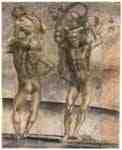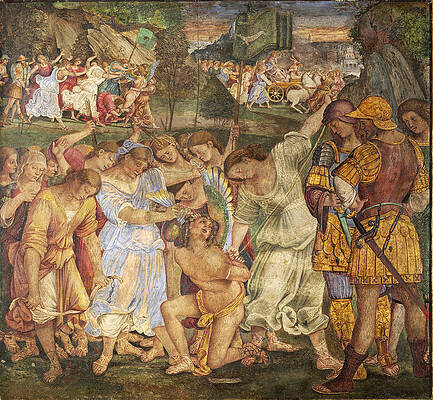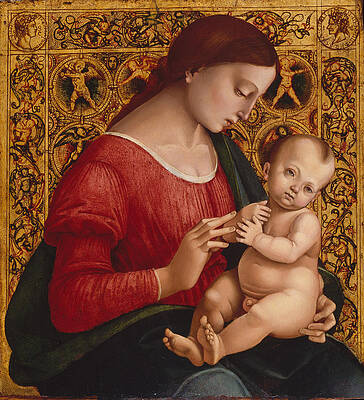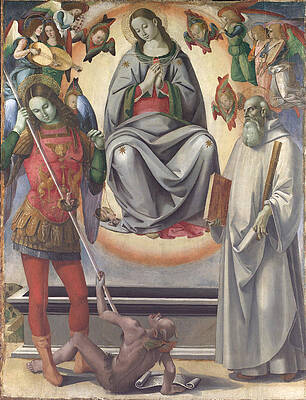Luca Signorelli
Paintings
Madonna of Mercy and Saints Sebastian and Bernardino da Siena
The Triumph of Chastity. Love Disarmed and Bound
Madonna and Child
Madonna And Child 2
Madonna And Child 3
The Virgin and Child with Saints
The Circumcision
The Adoration of the Shepherds
The Adoration of the Shepherds
The Holy Family
Coriolanus persuaded by his Family to spare Rome
The Assumption of the Virgin with Saints Michael and Benedict

Predella - Esther, and Life of Saint Jerome


The Triumph of Chastity - Love Disarmed and Bound

The Virgin and Child with Saints

Frescoes in the cathedral of Orvieto, Scene: The Damned

Scenes from the Life of St. Benedict




Drawings














Fine Art Prints | Greeting Cards | Phone Cases | Lifestyle | Face Masks | Men's , Women' Apparel | Home Decor | jigsaw puzzles | Notebooks | Tapestries | ...
Luca Signorelli (c. 1445 – 16 October 1523) was an Italian Renaissance painter who was noted in particular for his ability as a draughtsman and his use of foreshortening. His massive frescoes of the Last Judgment (1499–1503) in Orvieto Cathedral are considered his masterpiece.
Biography
Testament and Death of Moses, detail
He was born Luca d'Egidio di Ventura in Cortona, Tuscany (some sources call him Luca da Cortona). The precise date of his birth is uncertain; birth dates of 1441–1445 are proposed. He died in 1523 in Cortona, where he is buried. He was perhaps eighty-two years old. He is considered to be part of the Tuscan school, although he also worked extensively in Umbria and Rome.
His first impressions of art seem to be due to Perugia — the style of Benedetto Bonfigli, Fiorenzo di Lorenzo and Pinturicchio. Lazzaro Vasari, the great-grandfather of art historian Giorgio Vasari, was brother to Luca's mother; according to Giorgio Vasari he got Luca apprenticed to Piero della Francesca. In 1472 the young man was painting at Arezzo, and in 1474 at Città di Castello. He presented to Lorenzo de' Medici a picture which is probably the one named the School of Pan. Janet Ross and her husband Henry discovered the painting in Florence circa 1870 and subsequently sold it to the Kaiser Frederick Museum in Berlin. The painting was destroyed by allied bombs in WWII.[1] The painting's subject is almost the same as that which he also painted on the wall of the Petrucci palace in Siena—the principal figures being Pan himself, Olympus, Echo, a man reclining on the ground and two listening shepherds.
He executed, moreover, various sacred pictures, showing a study of Botticelli and Lippo Lippi. Pope Sixtus IV commissioned Signorelli to paint some frescoes, now mostly very dim, in the shrine of Loreto—Angels, Doctors of the Church, Evangelists, Apostles, the Incredulity of Thomas and the Conversion of St Paul. He also executed a single fresco in the Sistine Chapel in Rome, the Testament and Death of Moses, although most of it has been attributed to Bartolomeo della Gatta; another, the Moses Leaving to Egypt, once ascribed to Signorelli, is now recognized as the work of Perugino and other assistants.
Signorelli worked in Rome from 1478 to 1484. In the latter year he returned to his native Cortona, which remained from this time his home. In the Monastery of Monte Oliveto Maggiore (Siena) he painted eight frescoes, forming part of a vast series of the life of St. Benedict; they are at present much injured. In the palace of Pandolfo Petrucci he worked upon various classic or mythological subjects, including the School of Pan already mentioned.
Work in Orvieto
See also: Orvieto Cathedral § Chapel of the Madonna di San Brizio
Lamentation over the Dead Christ, detail, 1502
From the Monastery of Monte Oliveto Maggiore near Siena, Signorelli went to Orvieto, and produced his masterpiece, the frescoes in the chapel of S. Brizio (then called the Cappella Nuova), in the cathedral.
The Cappella Nuova already contained two groups of images in the vaulting over the altar, the Judging Christ and the Prophets, by Fra Angelico, who had begun the murals fifty years earlier. The works of Signorelli in the vaults and on the upper walls represent the events surrounding the Apocalypse and the Last Judgment. The events of the Apocalypse fill the space which surrounds the entrance into the large chapel.
The Apocalyptic events begin with the Preaching of Antichrist, and proceed to the Doomsday and The Resurrection of the Flesh. They occupy three vast lunettes, each of them a single continuous narrative composition. In one of them, Antichrist, after his portents and impious glories, falls headlong from the sky, crashing down into an innumerable crowd of men and women.
The events of the Last Judgment fill the facing vault and the walls around the altar: Paradise, the Elect and the Condemned, Hell, the Resurrection of the Dead, and the Destruction of the Reprobate.
Lamentation of Christ, Orvieto, Monte Oliveto
To Angelico's ceiling, which contained the Judging Christ and the Prophets led by John the Baptist, Signorelli added the Madonna leading the Apostles, the Patriarchs, Doctors of the Church, Martyrs, and Virgins. The unifying factor of the paintings is found in the scripture readings in the Roman liturgies for the Feast of All Saints and Advent.
Stylistically, the daring and terrible inventions, with their powerful treatment of the nude and arduous foreshortenings, were striking in its day. Michelangelo is claimed to have borrowed, in his own fresco at the Sistine Chapel wall, some of Signorelli's figures or combinations. The decoration of the lower walls, unprecedented in the history of art, are richly decorated with a great deal of subsidiary work connected with Dante, specifically the first eleven books of his Purgatorio, and with the poets and legends of antiquity. A Pietà composition in a niche in the lower wall contains explicit references to two important Orvietan martyr saints, S. Pietro Parenzo and S. Faustino, in the centuries preceding the execution of the lunette paintings.
The contract for Signorelli's work is still on record in the archives of the Cathedral of Orvieto. He undertook on April 5, 1499 to complete the ceiling for 200 ducats, and to paint the walls for 600, along with lodging, and in every month two measures of wine and two quarters of corn. The contract directed Signorelli to consult the Masters of the Sacred Page for theological matters. This is the first such recorded instance of an artist receiving theological advice, although art historians believe the two groups routinely discussed such matters. Signorelli's first stay in Orvieto lasted not more than two years. In 1502 he returned to Cortona. He returned to Orvieto and continued the lower walls. He painted a dead Christ, with Mary Magdalen and the Virgin Mary and the martyrs local Saints Pietro Parenzo and Faustino.The figure of the dead Christ, according to Vasari, is the image of Signorelli's son Antonio, who died from the plague during the course of the execution of the paintings.
Work in Siena, Cortona, Rome, and Arezzo
Signorelli paid great attention to anatomy. Two nude youths carrying a young woman and a young man
After finishing the frecoes at Orvieto, Signorelli was often in Siena. In 1507 he executed a great altarpiece for S. Medardo at Arcevia in the Marche, the Madonna and Child, with the Massacre of the Innocents and other episodes.
In 1508 Pope Julius II summoned artists to Rome, including Signorelli, Perugino, Pinturicchio and Il Sodoma to paint the large rooms in the Vatican Palace. They began work, but soon the pope dismissed all to make way for Raphael. Their work was taken down, except for the ceiling in the Stanza della Segnatura. Luca returned to Siena, but mostly lived in his hometown of Cortona. He was constantly at work, but the products of his closing years were not of the quality of his works from 1490–1505.
In 1520 Signorelli went with one of his pictures to Arezzo. He was partially paralysed when he began a fresco of the Baptism of Christ in the chapel of Cardinal Passerini's palace near Cortona, which (or else a Coronation of the Virgin at Foiano) is the last picture specified as his . Signorelli stood in great repute as a citizen; he entered the magistracy of Cortona as early as 1488, and held a leading position by 1524 when he died.
Signorelli paid great attention to anatomy. It is said that he carried on his studies in burial grounds. Certainly his mastery of the human form indicates that he had performed dissections. He surpassed contemporaries in showing the structure and mechanism of the nude in immediate action; and he even went beyond nature in experiments of this kind, trying hypothetical attitudes and combinations. His drawings in the Louvre demonstrate this and bear a close analogy to the method of Michelangelo. He aimed at powerful truth rather than nobility of form; colour was comparatively neglected, and his chiaroscuro exhibits sharp oppositions of lights and shadows. He had a vast influence over the painters of his own and of succeeding times, but had no pupils or assistants of high repute; one of them was a nephew named Francesco.
Vasari, who claimed Signorelli as a relative, described him as kindly, and a family man, and said that he always lived more like a nobleman than a painter. Vasari included Signorelli's portrait, one of seven, in his study in Arezzo, along with Michelangelo and himself. The Torrigiani Gallery in Florence contains a grand life-sized portrait by Signorelli of a man in a red cap and vest, and corresponds with Vasari's observation. In the National Gallery, London, are the Circumcision of Jesus and three other works. Legend holds that Signorelli depicted himself in the left foreground of his Orvietan mural The Rule of Antichrist. Fra Angelico, his predecessor in the Orvieto cycle, is thought to stand behind him in the piece. However, the figure thought to be Fra Angelico is not dressed as a Dominican friar, and Signorelli's supposed portrait does not match that in Vasari's study.
Major works
Annunciation, Volterra
The Scourging of Christ (c. 1480) - Tempera on roundheaded panel, 84 x 57 cm, Pinacoteca di Brera, Milan
Testament and Death of Moses (1481–1482) - Fresco, 350 x 572 cm, Sistine Chapel, Vatican
Sant'Onofrio Altarpiece (1484) - Panel, 221 x 189 cm, Museo dell'Opera del Duomo, Perugia
Martyrdom of St. Sebastian - Pinacoteca Comunale, Città di Castello
Madonna and Child (1484) - Panel, 170 x 117,5 cm, Uffizi, Florence
The Circumcision (c. 1490–91) - Oil on panel transferred to convas, 259 x 180 cm, National Gallery, London
Portrait of a Man (c. 1492) - Tempera on panel, 50 x 32, Gemäldegalerie, Berlin
The Damned Cast into Hell (c. 1499) San Brizio Chapel, Orvieto Cathedral, Orvieto, Italy
Madonna and Child with St. Joseph and Another Saint (1490–1492) - Panel, diameter: 99 cm, Galleria Palatina, Palazzo Pitti, Florence
The Adoration of the Shepherds (1496) - Painted for the church of San Francesco, Città di Castello
Lamentation over the Dead Christ (1502) - Wood, 270 x 240 cm, Museo Diocesano, Cortona
Portrait of Vitelozzo Vitelli (1500–1503) - Panel, Museo dell'Opera del Duomo, Orvieto
Mary Magdalene (1504) - Panel, Museo dell'Opera del Duomo, Orvieto
Calvary (1505)
The Coronation of the Virgin (1508) - painted for the Filippini Chapel in the church of San Francesco, Arcevia
The Trinity, the Virgin and Two Saints (1510) - Tempera on wood, 272 x 180 cm, Uffizi, Florence
Communion of the Apostles (1512) - Panel, 232 x 220 cm, Museo Diocesano, Cortona
Virgin and Child with Saints (1515) - Painted for church of San Francesco, Montone, now in the National Gallery, London
Madonna and Child with Saints (c. 1519-1523) - Tempera on panel, Museo di arte medievale e moderna, Arezzo
Immaculate Conception (c. 1523) - Panel, 217 x 210 cm, Museo Diocesano, Cortona
Madonna and Child with Saints - Panel, Museo Nazionale di Castel Sant'Angelo, Rome
References
See: Benjamin, Sarah, A Castle In Tuscany, pp. 63–67 (image of the painting at pp. 64–65), Murdoch Books, Australia, 2006.
Sources
Henry, Tom; Lawrence Kanter (2002). Luca Signorelli: The Complete Paintings. New York: Rizzoli.
James, Sara Nair, Signorelli and Fra Angelico at Orvieto: Liturgy, Poetry, and a Vision of the Endtime. Aldershot: Ashgate Publishing,2003 |ISBN= 0-7546-0813-1 |url=http://www.ashgate.com/default.aspx?page=637&calcTitle=1&title_id=3454&edition_id=3534
James, Sara Nair, “Penance and Redemption: The Role of the Roman Liturgy in Luca Signorelli’s Frescoes at Orvieto” in Artibus et Historiae vol XXII, no. 44 Fall, 2001.
James, Sara Nair. "Vasari on Signorelli: The Origins of 'The Grand Manner of Painting,'" in Reading Vasari, edited by Anne B. Barriault, Andrew Ladis, Norman E. Land, and Jeryldene M. Wood. London and Athens, GA: Philip Wilson Publishers and the Georgia Museum of Art, 2005.
James, Sara Nair, “Apocalypse in the Visual Arts” for the Encyclopedia of the Bible and Its Reception, published by Verlag Walter de Gruyter in Berlin (Germany), Volume A, 2009.
James, Sara Nair, “Antichrist in the Visual Arts” for the Encyclopedia of the Bible and Its Reception, published by Verlag Walter de Gruyter in Berlin (Germany), Volume A, 2009.
Henry, Tom, The Life and Art of Luca Signorelli. New Haven and London: Yale University Press, 2012
Public Domain This article incorporates text from a publication now in the public domain: Chisholm, Hugh, ed. (1911). Encyclopædia Britannica (11th ed.). Cambridge University Press.
Gilbert, Creighton (2002). How Fra Angelico and Signorelli Saw the End of the World. Penn State Press. ISBN 0-271-02140-3.
Riess, Jonathan B. The Renaissance Antichrist: Luca Signorelli’s Orvieto Frescoes, Princeton: Princeton University Press, 1995.
----
Fine Art Prints | Greeting Cards | Phone Cases | Lifestyle | Face Masks | Men's , Women' Apparel | Home Decor | jigsaw puzzles | Notebooks | Tapestries | ...
----
Artist
A - B - C - D - E - F - G - H - I - J - K - L - M -
N - O - P - Q - R - S - T - U - V - W - X - Y - Z
Retrieved from "http://en.wikipedia.org/"
All text is available under the terms of the GNU Free Documentation License














